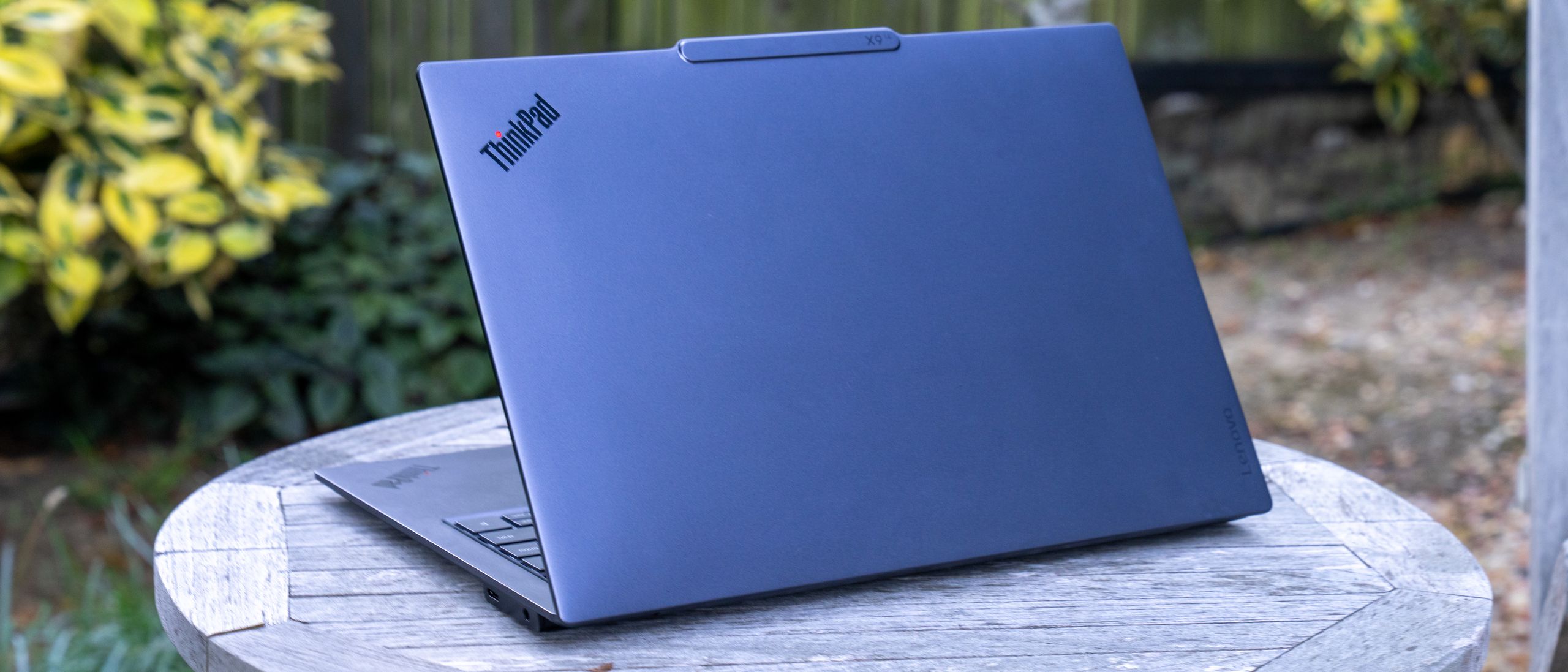Copyright Tom's Guide

The $1,500 ThinkPad X9 14 Aura Edition ($1,239 to start) is marketed as an AI-first, Copilot+ PC. Powered by an Intel Core Ultra 5 CPU, it's focused squarely on productivity: few ports and fewer frills with a solid input experience and an attractive display. Like the rest of the ThinkPad line, it's aimed primarily at businesses that need a simple, reliable machine to hand out by the dozens. After using our ThinkPad X9 14 review unit for a few weeks myself, I'm pleased by the design and utility of the laptop but I have a hard time recommending it as one of the best business laptops because the competition is just so good. While the no-frills experience has carried ThinkPads far, it's getting increasingly difficult to ignore the ARM-based "upstarts" that were once in the rearview, but have long since pulled ahead. I'll walk you through what I mean (and show you the test results from our lab that back up my experience) in this Lenovo ThinkPad X9 14 Aura Edition review. Lenovo ThinkPad X9 14 Aura Edition review: Cheat sheet Who is it for? Someone who needs a light and capable machine to wrangle office tasks, and is either subscribed to Microsoft's Copilot+ or doesn't want a Mac. What does it cost? This model of Lenovo ThinkPad X9 14 starts at roughly $,1239 at Lenovo's website, though it can be configured to cost as much as $2,200 if you kit it out with the most capable CPU and maximum RAM and storage. As configured, the model we review here would cost you roughly $1,459. What do we like? A great keyboard is paired with an attractive display, in a shell that's light and sturdy. What don't we like? There are better performing ARM-based machines at this price point, and the drawbacks of going with ARM over x86 Intel chips aren't as bad as they once were. Bottom Line? The Lenovo ThinkPad X9 14 is a sturdy, capable machine with a lot to like, but the competition is fierce—and usually cheaper. Lenovo ThinkPad X9 14 Aura Edition review: The ups Minor aesthetic updates, but remains sleek and sturdy Bright attractive display, if a little glossy Keyboard and touchpad remain on point If it ain't broke, tweak it The ThinkPad aesthetic has seen a few tweaks in the last few generations, but you aren't going to be mistaking this machine for anything else.The bezels around the 14-inch display are likely be a bit thinner than the ThinkPad you may have been handed at your last job. And the display's frame bumps out a bit at the top, as if someone crammed the webcam, microphone, and ambient light sensors in as an afterthought. I like it: it breaks up the monotony of the otherwise grayish box with that telltale red dot, and gives my thumb something to focus on when I'm lifting the display on its rigid yet smooth hinge. I doubt anyone who isn't shooting photos will spend as much time staring at the sides and undersides of laptops as I regularly do, but I like the tapered profile on offer here, propped up on a grille that I eagerly hoped was some robust audio loadout. Nope, those are fans, and not the pair of chibi-subwoofers that my heart desired. The slit that I at first blush assumed was a Smart Card reader are the speakers; there's one on each side. It's for the best: the side-firing speakers means audio isn't blocked by my mitts when I'm tapping on the keyboard, nor muffled against my lap or table if they were located underneath. And they actually sound pretty good! I'm no audiophile, and while I don't typically look to ThinkPads for refined aural experiences the sound on offer here is rich and clear. The bass isn't tremendous, but it's not the tinny warble I've grown to expect from laptops barely over half an inch think. More importantly, dialogue is clear, and the Dolby Settings app offers a few different profiles and equalizers so you can prod things where you need them. A wide, spacious keyboard is joined by the traditional ThinkPad branding on the keyboard tray and lid, and the TrackPoint nub is gone, leaving room for a more expansive touchpad. The keyboard experience remains excellent. The keys offer a comfortable amount of travel with every press, making for an error free typing experience. The touchpad is similarly appealing, tracking swipes and gestures with aplomb. But while an excellent input experience has been par for the course for Lenovo's wares for time immemorial, what was once a Lenovo mainstay is kind of de rigeur for laptops these days. The 8MP webcam serves up crisp, clear images, albeit with colors that are just a little flat. It also supports Windows Hello, care of its infrared camera, so you can login with your face, in addition to the keyboard's fingerprint reader. My only real gripe is that the privacy shutter is a digital one, on the keyboard, and not a physical one on the lid, but we're picking at nits here. Worth a second look The X9 14 sports a 14-inch, 2,880 x 1,800 OLED display. It looks great: colors are vibrant, and remain true even at awkward angles. We recorded 121.7% of the sRGB spectrum. As close to 100% as possible is ideal; being under and over that limit means colors tend to lean undersaturated or oversaturated, respectively. They looked fine here, popping with life without being garish. The display also offers a 120Hz refresh rate; while the anemic, 8GB Intel Arc 130V GPU on offer here means gaming isn't really an option, a touch of silky smoothness in supported media, or just across the UI, is always appreciated. That's all assuming you're inside. The X9 14 I reviewed has a touch screen display, and the glossiness means that when the sun hits your text just right you'll be self-reflecting more than you anticipated. It isn't too much of a bother to move the machine or adjust the lid, but if you're shopping I'd opt for a model without the touchscreen. At least it's bright: we saw an average of 443 nits of brightness on the display. At 10 hours and 9 minutes on our automated battery test, the X9 14 isn't exactly a marathoner when compared to its ARM-powered associates. But that should be enough to get you through the average working day, and plenty of juice if you can find the occasional outlet. Our test consists of setting the display to 150 nits of brightness and surfing the web, so you can expect to see less when putting the machine through its paces. Anecdotally, I saw closer to between 5 and 6 hours in my testing. But I kept the brightness near maximum, and when I wasn't wordsmithing I was puttering about in Lightroom and tinkering with tools like Ollama and LM Studio, to get an idea of how this AI-centric Copilot+ PC might handle local large language models (spoiler: not well). These are taxing operations, literally maxing out both memory and CPU performance. But while the machine warmed up the fans never got egregiously loud, or uncomfortable — we measured 92.1 degrees Fahrenheit at the warmest point. Suffice to say, your average web-browsing and document wrangling tasks will be handled with aplomb. Lenovo ThinkPad X9 14 Aura Edition review: The downs Outpaced by ARM-based competitors AI claims remain a marketing dream Losing at ARM wrestling Intel's x86-based CPUs have had a rough go of it lately, outpaced by ARM-based competitors, and outpriced by Apple, of all manufacturers. And after putting our ThinkPad X9 14 Aura Edition review unit through our battery of performance tests in the lab, I'm sorry to report the Intel Core Ultra 5 CPU holds this business laptop back from true greatness. To show you what I mean, have a look at our performance test results below. I kept this performance comparison simple by putting the X9 14 up agasint the Lenovo ThinkPad X1 Carbon Gen 13 Aura Edition as well as the Apple MacBook Air M4. Price-wise, Apple's ultraportable is the cheapest in the bracket at $999 while the Lenovo ThinkPad X1 Carbon Gen 13 Aura Edition laptop cost ~$1,999 when reviewed it earlier this year. That leaves this ThinkPad X9 14 Aura Edition squarely in the middle at rouhgly $1,450. Of course the test results turn things on their head, with Apple's laptop pulling far ahead of the competition while the pair of Lenovo machines are within spitting distance of one another, despite their ~$400 price difference. On the one hand, I try not to play favorites. On the other hand, I'm an old-school PC enthusiast, defined as multiple DIY'd Linux and Windows machines with beefy GPUs, case panels that are never quit affixed, and horrid cable management. On my third hand: with cross-platform apps being as prevalent as they are, and price-to-performance ratios this skewed, crossing the Apple Rubicon to save cents could make sense. AI-first falls flat There's a reason most consumer interactions with AI happen in the browser. Large language models (LLMs) thrive with access to plenty of RAM: ideally speedy VRAM from a GPU, though system RAM has a role to play too. This machine lacks much of either. In fact, outside of functionality built in to Office 365 apps and the on-again, off-again, Windows Recall, you'll be hard-pressed to find AI-powered experiences you can take advantage of locally, on this hardware. I should note, this isn't an indictment of this machine. Yes, it's outpaced by Apple's wares on the benchmarks; x86 offerings in general are being trounced by ARM. But there are still plenty of workloads that preclude moving to a different CPU architecture. My gripe is with marketing materials that boast about a "Neural processing unit (NPU) with up to 48 TOPS AI performance." That's doesn't mean a whole lot for folks trying to wade into this Brave New World of AI, that want to find hardware to help them experience it. As it stands, unless you're a Copilot+ subscriber, which leaves you reliant on web connectivity anyway, I'd advise against letting a Copilot+ badge factor into your purchasing decision. Lenovo ThinkPad X9 14 Aura Edition review: Verdict When I checked out the ThinkPad X1 Carbon Gen 13 Aura Edition, my chief gripe was over the price relative to its performance; slash about $400 of the sticker, and I'd be more agreeable to it. The ThinkPad X9 14 is literally that. It's marginally slower, owing to the weaker processor, but you aren't missing much in any other direction. Given that the RAM is soldered on I'd spend just a little bit extra (+$60, at time of writing) and get the Ultra 5 238V model with 32GB of RAM. All that being said, Apple's MacBook Air M4 starts at $999; models with 24GB of RAM and 512GB of storage start at $1,399. I like this machine. It tackles the job its meant to and the price feels fair, given the build quality and performance on offer. More importantly, after just a few minutes in a search engine I found the maintenance manual, with a parts list, schematics, instructions on replacing components... It's not quite a Framework but if you're the type to tinker (and up for voiding warranties) you can truly own this machine, which has become increasingly important to me. But your mileage may vary. If you don't have particular use cases that preclude using a Mac, the MacBook Air is might be too good a deal to pass up.



